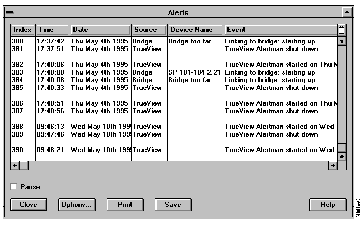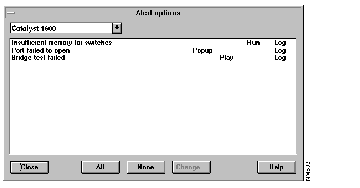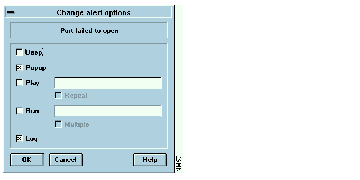Alert Manager is automatically installed when you follow the instructions on installing the TrueView software in your TrueView Applications Installation and User Guide.
Starting TrueView Alert Manager
- The screen displays a window containing the Alert Manager icon (see Figure 2-1).
Figure 2-1: The Alert Manager Icon

Underneath the Alert Manager icon is the number of unacknowledged alerts. Unacknowledged alerts are those alerts that have occurred since you last looked at the list of alerts.
- Double-click on the Alert Manager icon. The screen displays the main Alert Manager window, which contains the list of alerts that have occurred. The number of unacknowledged alerts becomes zero. Figure 2-2 shows this window.
Figure 2-2: The Main Alert Manager Window

- To exit from an Alert Manager window that provides information but does not allow you to input information, click on the Close button.
- To exit from any other window or pop-up box within Alert Manager:
- and save any changes, click on the OK button
- without saving any changes, click on the Cancel button
- To get context-sensitive help, click on the help button.
- To get help contents, refer to the TrueView Applications Installation and User Guide
- The screen displays the main Alert Manager window with the list of alerts that have occurred. When a new alert occurs, a corresponding message scrolls onto the bottom of the list.
- Either set the Pause check box to on
Or:
Click on the scroll bar so that the last acknowledged alert is no longer visible.
- The list is paused. When a new alert occurs:
- The list does not scroll
- The number of unacknowledged alerts increases by one
- A message at the end of the window states how many alerts are pending
- The screen displays the main Alert Manager window with the list of messages about alerts that have occurred. The Pause check box is set to on. When a new alert occurs, the list does not scroll.
- Set the Pause check box to off
Or:
If the list is scrolled so that the last alert is not visible, scroll down to the bottom of the list of alerts.
- The list is no longer paused. When a new alert occurs, it scrolls onto the bottom of the list.
There are several different ways that you can know whether an alert has occurred:
- When a new alert occurs and if the screen displays the TrueView main window with the bell icon, Alert Manager increments the number beneath the bell icon and does one, or a combination, of the following:
- Produces a beep sound
- Displays a pop-up window
- Plays a sound other than a beep
- Runs an application
- When a new alert occurs and if the screen displays the Alert Manager main window with the list of alerts and the Pause check box is selected, the screen displays a message at the bottom of the list stating how many unacknowledged alerts are pending, and Alert Manager does one, or a combination, of the following:
- Produces a beep sound
- Plays a sound other than a beep
- Runs an application
- When a new alert occurs and if the screen displays the Alert Manager main window with the list of alerts, and the pause check box is clear, Alert Manager scrolls an alert message onto the bottom of the list of alerts, and does one, or a combination, of the following:
- Produces a beep sound
- Plays a sound other than a beep
- Runs an application
- The screen displays the main Alert Manager window with a message giving the number of alerts that are pending.
- Unpause the list. To do this, see the section "Enabling the List to Scroll" earlier in this chapter.
- The pending alerts are scrolled onto the bottom of the list of alerts and the number of unacknowledged alerts becomes zero.
The screen displays the main Alert Manager window.
Step 1 Click on the Options button. The screen displays the window shown in Figure 2-3.
Figure 2-3: A List of Events For Which You can Produce Alerts

Step 2 To specify an alert for a device, click on the box at the top left corner of the window. A drop-down menu appears. Click on alerts for the desired device, for example, if you want to produce an alert for an event concerning a bridge, click on Bridge. Alert Manager displays the list of events for that device.
Step 3 To specify an alert when an event in the list occurs, click on that event. Alert Manager highlights the event in the list. To specify alerts for all the events listed, click on the All button. Alert Manager highlights all the list elements.
Note To deselect a selected event, that is, remove the highlight, click on it.
To deselect all the selected events, click on the None button.
Step 4 Click on the Change button. The screen displays a dialog box like the one in Figure 2-4.
Figure 2-4: Specifying the Type of Alert for a Particular Event

Step 5 Alert Manager can perform a range of actions when the event you selected occurs. To specify the action you want, see Table 2-1.
Table 2-1: Specifying Alerts
| Alert Manager Action
| Your Action
| What Happens when the Alert Condition You Selected Occurs?
|
|---|
| Log the alert
| Select the log check box. Click on the OK button.
| Alert Manager logs the alert in the alert list in the main Alert Manager window.
|
| Beep
| Select the beep check box. Click on the OK button.
| The computer produces a beep.
|
| Display a pop-up window
| Select the Pop-up check box. Click on the OK button.
| If the main Alert Manager window is not open, the screen displays a pop-up window showing the alert text. To remove the pop-up window, click on the OK button. To display the list of alerts, click on the List button.
|
| Play a sound
| Set the Play check box to on. Specify the sound you want in the edit check box situated to the right of the Play check box.
| If the repeat check box is set to on, the sound plays continuously unless the main Alert Manager window, which contains the list of alerts, is open. See Note 1 below.
|
| Run an application
| Set the Run check box to on. Specify the application in the edit box to the right of the check box. To make Alert Manager start the application whether the application is already running or not, set the Multiple check box to on. Click on the OK button.
| If the application is already running when the alert occurs and the multiple check box is off, nothing happens. Otherwise, the application starts running.
|
Note If the Play check box is set to on, but the edit box beside it is blank, Alert Manager searches for a default filename based on the alert.
Note To specify a combination of the above actions, set each of the corresponding check boxes in the "Your Action" column in
Table 2-1 to on.
The check boxes in this window have the three states as shown in Table 2-2.
Table 2-2: Check Box States
| Appearance of Check Box
| State of Check Box
| Meaning
|
|---|
| An 'X' in the check box
| Selected
| Alert Manager performs the action associated with the check box when any of the selected alerts occur.
|
| The check box is empty
| Clear
| Alert Manager does not perform the action associated with the check box when any of the selected alerts occur.
|
| The check box is grey
| More than one alert is selected and the current setting for these is different
| Alert Manager performs the action associated with the check box when some of the selected alerts occur. For example, if some of the selected alerts that occur have the beep action associated with them and some do not, the check box is grey.
|




